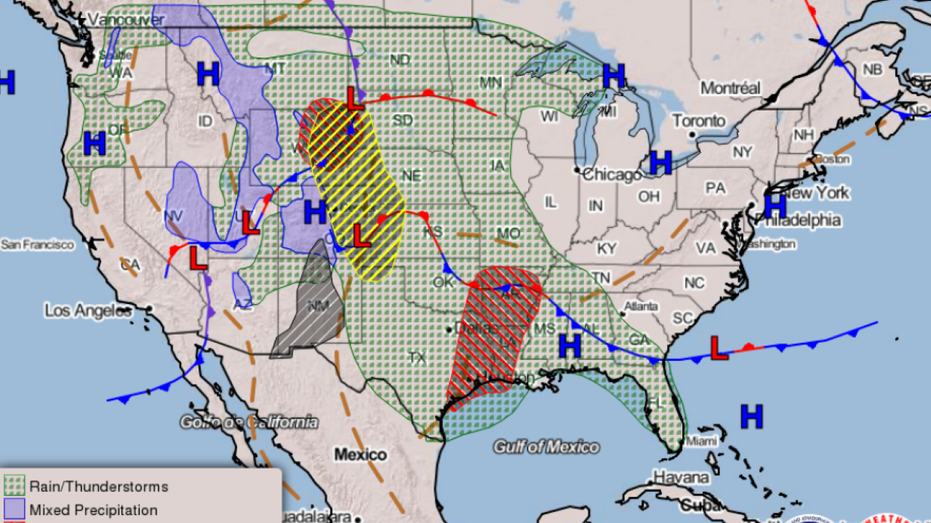Artificial intelligence already has a lengthy track record in the field of weather prediction, where it has helped prognosticators make faster, more accurate forecasts for nearly three decades.
But now, AI has the potential to take the next step when it comes to predicting sun, rain, wind and snow by doing the work on its own, without using various models that human forecasters have relied on for generations.
Hendrik Tolman, senior adviser for advanced modeling systems at the National Weather Service, told Fox News Digital this possibility is now on the horizon and is actively being explored.
“Companies like Nvidia and IBM have made a lot of progress the last six months or 12 months in trying to see how they can use AI to do the same as our big computer models are doing, to provide a prediction for the future just based on AI rather than going through a computer model,” Tolman said.
OPENAI SUGGESTS VOLUNTARY AI STANDARDS, NOT GOVERNMENT MANDATES, TO ENSURE AI SAFETY
“Or having AI emulate as if you have even more models and get a better idea about how to merge all the data we have.
“That is really new, that is really the last year or so. There’s a lot of progress on that.”
It’s a relatively new idea in a field that benefited from AI relatively early. Tolman said AI was first used in 1995 to help forecasters make sense of data being received from a set of satellites used to predict wind speed and surface temperatures.
Since then, AI has been used by weather forecasters to absorb as much data as possible and use that information to make more accurate weather predictions, such as the chances of a hurricane developing based on current weather conditions. AI has also been used to help tweak some of the current weather models in use when needed and even to distill all the data into summaries that people can read and understand.
REGULATE AI? GOP MUCH MORE SKEPTICAL THAN DEMS THAT GOVERNMENT CAN DO IT RIGHT: POLL
“Our forecasters are starting to use more and more AI tools for translating that into a simple message for the public that is useful and can help the public to make right decisions,” Tolman said.
But this work being done by AI has largely focused on helping people make faster, more accurate predictions based on the several weather models that were developed over decades. The big question, Tolman said, is whether AI can do all the work itself, without the human-designed models.
“That is really AI coming more into the core of the tools that we have and starting to replace or augment some of the models,” he said. “Some of the attempts that we are trying to do is to see to which level AI could actually replace complete models.”
Tolman said it’s an open question whether AI is up to the task.
“Some of the attempts that we are trying to do is to see to which level AI could actually replace computer models,” he said. “We don’t know anywhere near enough to see if we would trust its reliability for doing this.”
Tolman noted, for example, that if ChatGPT is asked for a weather update, it will spit out something that looks like a legitimate forecast.
“But it is not clear to me whether the chatbot comes up with it itself, or whether they actually harvest the information that we put out through models,” he said. “That is the question. … We are nowhere near mature enough in the science to be able to answer this.”
He said a related issue is whether AI could accurately predict extreme weather events.
In terms of helping people make better assessments under the various weather models now in use, Tolman said using AI is a “no-brainer.”
“We use AI already in operations because it was better than what we used before,” he said.
Discovering the outer limits of AI’s ability to predict the weather will take time and more people. The National Oceanic and Atmospheric Administration, which houses the National Weather Service, is on a hiring spree for people with AI experience, and Tolman, who was born in the Netherlands and is now a U.S. citizen, says finding the right people with an AI background is his first challenge.
“The biggest problem that we have with computer-based stuff right now is that when I started my career 30 years ago, a hot thing to do in computers was weather,” he said. “Now everybody wants to be in video gaming and stuff like that.
“We have a hard time getting the next generation interested in our type of work compared to other computer work, and this is one of the reasons why we will probably be doing a lot more outreach and branding in the next few years.
“It used to be very easy to hire people in computer sciences for weather. Now we have to work for it.”
























